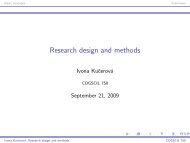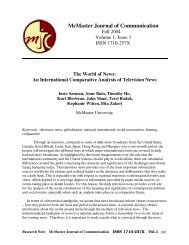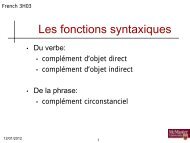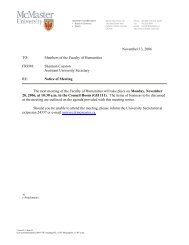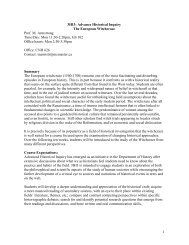The Syntax of Givenness Ivona Kucerová
The Syntax of Givenness Ivona Kucerová
The Syntax of Givenness Ivona Kucerová
Create successful ePaper yourself
Turn your PDF publications into a flip-book with our unique Google optimized e-Paper software.
1.5 <strong>The</strong> distribution <strong>of</strong> pronouns: G-movement as a last<br />
Resort<br />
In this section (i) I will provide independent evidence for the assumption that G-movement<br />
is a last resort operation. (ii) I will also address the question <strong>of</strong> what happens if α G is<br />
required to move but the movement is independently blocked by syntax. I will also introduce<br />
an observation that elements that are given by their lexical entry, such as pronouns,<br />
do not undergo G-movement. I will use the difference between lexically given items and<br />
non-lexically given items to investigate when G-movement must take place.<br />
I will first look at cases in which G-movement is independently blocked. In contrast to<br />
the previously discussed cases where α G was able to locally G-move, we will now consider<br />
cases in which α G cannot move at all. We will see that, in such a configuration, if α G is<br />
asymmetrically c-commanded by a new element, α G must be realized by a pronoun, i.e.,<br />
an element that comes marked as given from the lexicon. I will argue that if G-movement<br />
<strong>of</strong> α is required, α must G-move at least once. On the other hand, as we will see, if α G<br />
is trapped in a position that is not asymmetrically c-commanded by any new element, α G<br />
does not need to be lexically given. This fact will provide independent evidence for the<br />
assumption that G-movement is a last resort operation.<br />
I will refine this analysis in chapter 4 where I will introduce a global comparison system<br />
which will enforce lexical givenness in cases that would not be otherwise interpreted<br />
as given. In this chapter, however, we will stay with the surface oriented generalization.<br />
A question we have not asked yet is whether G-movement applies to all given elements.<br />
<strong>The</strong> answer is no. G-movement does not apply to pronouns. To see this, consider the<br />
example in (57). As we can see, there is a difference in the position <strong>of</strong> the same given<br />
element depending on whether the element is realized as a full DP (Pavel) or as a pronoun<br />
(ho/jeho, ‘him’). 21<br />
(57) What do you know about Pavel?<br />
a. Marie ho viděla na nádraží. ̌new > pronoun<br />
Marie.Nom him.Acc saw on railway-station<br />
b. #Marie Pavla viděla na nádraží. # new > DP<br />
Marie.Nom Pavla.Acc saw on railway-station<br />
21 Personal pronouns in Czech come in two flavors: weak pronouns, in this case ho, and strong pronouns,<br />
in this case jeho (Cardinaletti and Starke, 1999). <strong>The</strong>y differ in their syntactic distribution and interpretation.<br />
Crucially, weak pronouns are excluded from the left edge <strong>of</strong> a prosodic constituent, including the sentence<br />
initial position. <strong>The</strong> reason is that Czech requires main word stress to be aligned to the left edge <strong>of</strong> a prosodic<br />
constituent (see, for example, Petr et al. 1986; Palková 1994; van der Hulst 1999) and since weak pronouns<br />
cannot be stressed they are excluded from the left edge. If a pronoun needs to be, for instance, in the sentence<br />
initial position, it must be realized as a strong pronoun. For further details about the distinction between weak<br />
and strong pronouns see Cardinaletti and Starke 1999. More details about distributional properties <strong>of</strong> Czech<br />
weak pronouns can be found at Vos and Veselovská 1999.<br />
34





